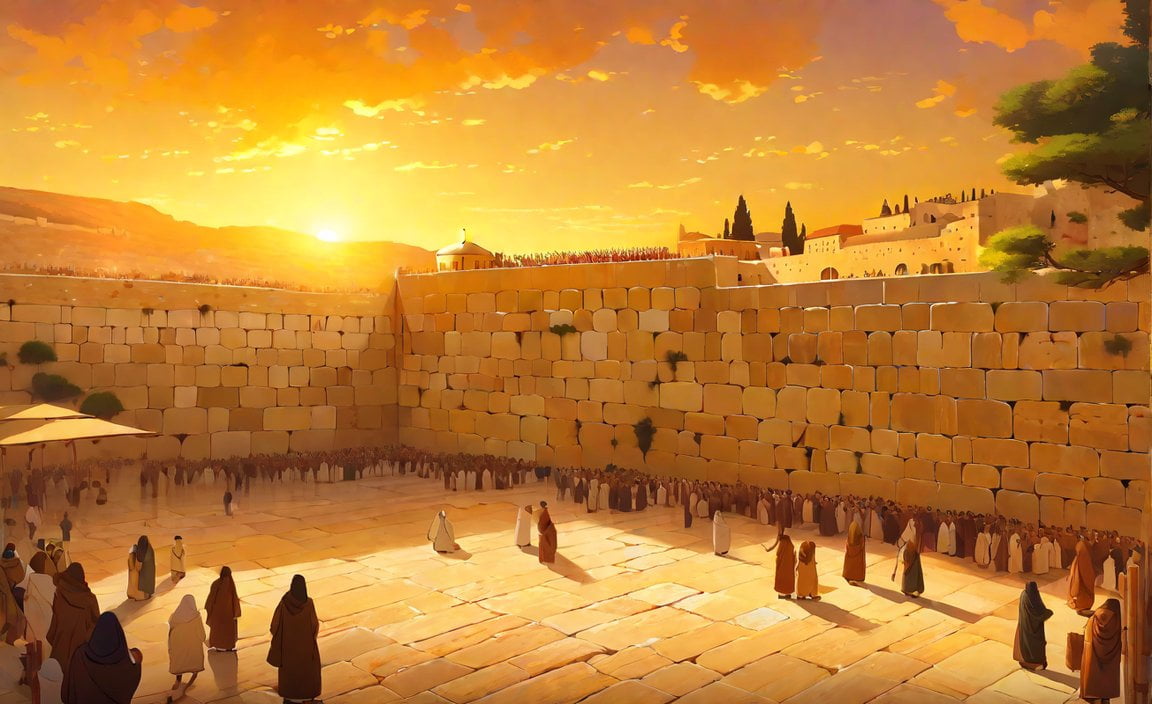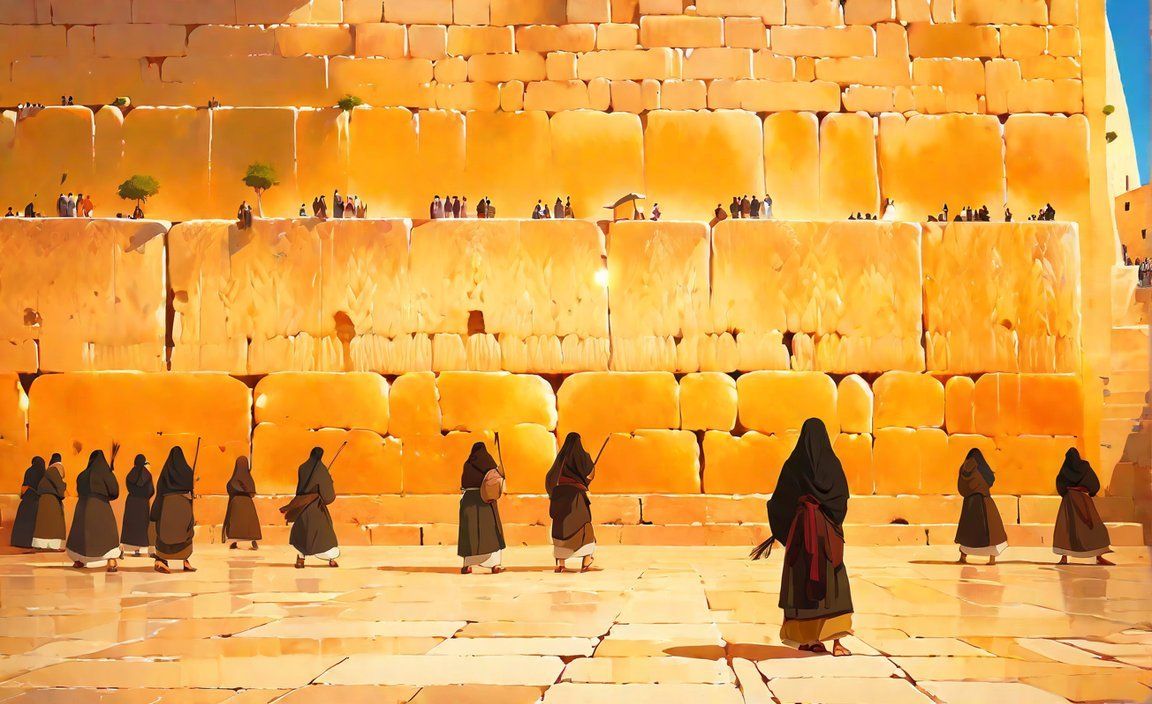Welcome to “Unveiling the Symbolic Significance: 10 Facts About the Western Wall,” where we embark on a fascinating journey through the rich history and cultural importance of this iconic religious site. As we explore the Western Wall, also known as the Wailing Wall, we will unearth ten compelling facts that shed light on its profound religious, historical, and architectural significance. Join us as we delve into this ancient structure, revealing its symbolism and its pivotal role in shaping tradition and faith.
Key Takeaways:
- The Western Wall is considered the holiest site in Judaism and is located in the Old City of Jerusalem.
- It is the only remaining wall from the ancient Jewish Temple, where believers think God’s Presence still resides.
- The wall stretches about 187 ft (57 m) and can accommodate up to 60,000 people.
- There are four ancient gates along the Western Wall named after scholars and researchers from the 19th century.
- The Western Wall consists of 45 layers of stone, 28 above ground and 17 still underground.
- The top half of the Western Wall’s stone courses above the Prayer Plaza are from Muslim restoration, while the others are original stones from the Second Temple period.
- Jews were forbidden from accessing the Western Wall for 19 years.
- Over a million notes are placed by visitors each year at the Western Wall as prayers.
10 Facts About the Western Wall
The Western Wall, located in the heart of the Old City of Jerusalem, is a site of immense religious and historical significance. As an experienced journalist with a passion for cultural history, I am excited to share with you ten intriguing facts about this iconic religious landmark.
1. A Sacred Site for Judaism
The Western Wall is the holiest site in Judaism and holds immense significance. It is the only remaining wall from the ancient Jewish Temple, where believers perceive that God’s Presence still dwells. This connection to their ancestors and their religious heritage makes the Western Wall a place of deep reverence and devotion for Jewish people worldwide.
2. A Monumental Structure
The Western Wall spans an impressive length, expanding to about 187 feet (57 meters). This immense size allows the prayer plaza in front of the wall to accommodate up to 60,000 people during special occasions and religious festivities. The sheer scale of the wall speaks to its historical and architectural significance.
3. Gates of the Western Wall
Four ancient gates line up along the length of the Western Wall, each carrying historical and symbolic value. These gates were named after prominent scholars and researchers of the 19th century who conducted extensive studies on Jerusalem and its ancient structures. The names of these gates pay tribute to the dedication and contributions of these individuals.
4. Construction and Composition
The Western Wall is constructed using 45 courses of stone, with 28 above ground and 17 still underground beneath the Western Wall Plaza. The different layers of stones represent layers of history, each telling a story of the site’s evolution over time. This unique construction style emphasizes the ancient origins of the wall and adds to its mystique.
5. Restored and Original Stones
The top half of the stone courses above the Prayer Plaza are from a Muslim restoration, while the lower ones are mostly original stones from the Second Temple period. This blend of restored and original stones creates an intriguing contrast, showcasing different historical periods and highlighting the wall’s resilience throughout centuries of change.
6. Restriction and Liberation
For a period of 19 years, the Western Wall was off-limits to Jews. During Jordan’s occupation of East Jerusalem from 1948 to 1967, Jewish access to the Western Wall was prohibited. However, with the reunification of Jerusalem in 1967, all faiths gained access to this sacred site once again, strengthening its importance as a symbol of religious freedom.
7. Prayers and Pleadings
The Western Wall is a site where countless prayers are expressed. Each year, it receives over a million notes placed by visitors who come to pray and seek solace. These heartfelt messages, sometimes written on small pieces of paper carefully folded into cracks in the wall, demonstrate the significance of the site as a place where people seek spiritual connection and guidance.
In Summary
The Western Wall stands as a testament to the rich history, spirituality, and faith of Judaism. Its ancient and enduring presence serves as a powerful reminder of the connection between past, present, and future generations. As an experienced journalist with a passion for cultural history, I am honored to share these ten fascinating facts about the Western Wall, shedding light on its symbolism and role in shaping tradition and faith.
Sources:
[^1^]: Wailing Wall Facts An Ancient Structure In Jer…
[^2^]: 6 fascinating facts you never knew about the Western Wall
[^3^]: What is The Wailing Wall in Jerusalem?
[^4^]: 7 Interesting Facts About The Wailing Wall
If you’re curious about fascinating facts about flowers, check out our article on fact flowers. Discover the incredible wonders of the floral world and learn something new today!
For a dose of fun and interesting information, explore our collection of muscular fun facts. From jaw-dropping feats of strength to mind-boggling muscle facts, you won’t believe what you’ll find!
Step into a world of shoe trivia and learn some surprising facts about footwear with our article on shoe facts. Prepare to be amazed by the history, innovation, and quirky tidbits surrounding the shoes we wear every day.
Delve into the captivating world of copper with our collection of copper fun facts. Uncover the hidden secrets of this versatile metal and its fascinating impact on various aspects of our lives.
Got milk? Discover an array of interesting and surprising facts about this staple beverage with our article on fun facts about milk. Prepare to be amazed by the nutritional benefits, production process, and cultural significance of milk!
Calling all biology enthusiasts! Dive into a world of intriguing information about biologists and their discoveries with our article on fun facts about biologists. Uncover the remarkable stories and achievements behind some of the greatest minds in the field of biology.
Unravel the mysteries and wonders of Uganda with our collection of fun facts about Uganda. From breathtaking landscapes to vibrant culture and diverse wildlife, Uganda has something extraordinary to offer. Click here to explore more about this captivating East African country.
Fact 2: The Role of the Western Wall in Jewish Tradition
The Western Wall, also known as the Wailing Wall or the Kotel, plays a central role in Jewish tradition and holds deep historical and religious significance for the Jewish people.
The Symbolic Connection to the Ancient Temple
The Western Wall is located in the Old City of Jerusalem and is the only remaining wall of the Temple Mount, the site of the First and Second Temples of Jerusalem. Jews believe that the Divine Presence never left the Western Wall, making it a sacred connection to the ancient Temple and a place of immense spiritual importance.
A Place of Prayer and Lamentation
For centuries, the Western Wall has been a site of prayer and pilgrimage for Jews around the world. It is a place where individuals come to pour out their hearts, offer prayers, and seek solace. Many Jews also come to lament the destruction of the Temple, praying for its restoration.
The Unity of the Jewish People
The Western Wall holds symbolic significance as a unifying force for the Jewish people. Regardless of their geographical location or religious affiliation, the Western Wall serves as a focal point that brings Jews together in their shared history, faith, and hopes for the future.
Preservation of Jewish Identity
The Western Wall serves as a tangible reminder of Jewish history and the resilience of the Jewish people. It stands as a testament to their unwavering connection to their roots, reinforcing their cultural, religious, and national identity.
The Intersection of Tradition and Faith
The Western Wall represents the intersection of tradition and faith within Judaism. It embodies the rich tapestry of customs, rituals, and practices that have been passed down from generation to generation. Through its physical presence, the Western Wall serves as a tangible link between past, present, and future, reinforcing the continuity of Jewish tradition.
A Site of Pilgrimage and Inspiration
The Western Wall is a significant pilgrimage site for Jews from all walks of life. It holds a special place in the hearts of those who come to experience its spiritual energy, seek inspiration, and offer prayers. The powerful atmosphere surrounding the Western Wall is believed to strengthen faith, foster introspection, and provide a connection to the divine.
A Focus of Tension and Controversy
The Western Wall’s historical and religious significance has also led to tensions between different groups. Disputes over access, prayer rights, and the overall status of the site have at times caused conflicts among various religious and political factions. Efforts to find a harmonious balance that respects both tradition and modernity continue to shape the ongoing dialogue surrounding the Western Wall.
Key Takeaways:
- The Western Wall holds deep historical and religious significance for the Jewish people.
- It symbolically connects Jews to the ancient Temple and serves as a place of prayer and lamentation.
- The Western Wall unifies the Jewish people, regardless of geographic location or religious affiliation.
- It preserves Jewish identity and reinforces the continuity of Jewish tradition.
- The Western Wall is a site of pilgrimage, inspiration, and a connection to the divine.
- The historical and religious significance of the Western Wall has led to tensions and debates surrounding access and status.
Sources:
– Encyclopedia Britannica: source
– My Jewish Learning: source
Fact 3: The Architectural Features of the Western Wall
The Western Wall stands as a magnificent testament to the architectural prowess of the Second Temple period. Let’s delve into the fascinating architectural features that make this iconic structure a marvel to behold.
Layered Stones Grounded in History
One of the notable architectural features of the Western Wall is its composition of layered stones. The visible section at the Prayer Plaza consists of an impressive 46 layers, with 17 layers remaining underground. Above ground, 28 layers of stone showcase the intricate craftsmanship of ancient builders [^4^].
Height and Burial: A Hidden Story
The Western Wall impresses not only with its exposed height but also with the layers of history buried beneath the plaza. From its foundation to the top, the Wall reaches a remarkable height of 105 feet. However, buried beneath the plaza lies 43 feet of the Wall, equivalent to 17 layers of stone. This hidden portion serves as a reminder of the ongoing archaeological excavations that reveal new insights into the site’s rich past [^3^].
A Blend of Restorations
Over time, the Western Wall has undergone various restorations that contribute to its unique architectural makeup. The top half of the stone courses is a result of Muslim restoration, while the lower portions predominantly date back to the Second Temple period. This blend of historical layers reflects the complex history of the Wall and its continuous significance in different eras [^2^].
An Architectural Window to the Past
The Western Wall not only represents a historical marvel but also offers a glimpse into the magnificent Second Temple. The remaining section of the Wall encompassed the westernmost boundary of the original temple complex. As visitors stand before its towering height, they witness the grandeur of the past and discover the architectural ingenuity that defined the ancient Jewish temple [^2^].
Key Takeaways:
- The Western Wall comprises 46 layers of stone, with 17 layers hidden beneath the plaza.
- The exposed section of the Wall stands at an impressive height of 105 feet.
- Muslim restorations can be observed in the top half of the stone courses, while the lower sections originate from the Second Temple period.
- The Wall serves as both a historical monument and a symbolic connection to the ancient Jewish temple.
Sources:
[^2^]: Tourist Israel
[^3^]: The Kotel
Fact 4: Historical Significance of the Western Wall for Different Religions
The Western Wall, also known as the Wailing Wall, holds immense historical and religious significance for different religions. Let’s dive into its fascinating story and explore the impact it has had on various faiths.
Historical Significance:
- The Western Wall is located in the Old City of Jerusalem, Israel, and is the remaining wall of the Second Temple, which was destroyed by the Romans in 70 CE.
- It was one of four retaining walls that supported the Temple Mount until the Second Temple’s destruction, being the closest to the Holy of Holies within the Temple.
- After the Temple’s destruction, the Western Wall became a popular place of prayer and a symbol of Jewish heritage and resilience.
Jewish Significance:
- The Western Wall is of utmost importance to Jews worldwide and is considered the holiest site in Judaism.
- It serves as a place of prayer, reflection, and mourning for the destruction of the Temple.
- Many Jewish visitors to the Western Wall leave prayers written on small pieces of paper within the cracks of the wall, a deeply symbolic act.
Islamic Significance:
- The Western Wall is also a significant site for Muslims as it is located adjacent to the Al-Aqsa Mosque, the third holiest site in Islam.
- According to Islamic tradition, it is believed that the Prophet Muhammad tied his winged steed, Buraq, to the Western Wall before ascending to heaven during the Night Journey.
- The proximity of the Western Wall to the Al-Aqsa Mosque underscores its importance in Islamic history and faith.
Christian Significance:
- For Christians, the Western Wall symbolizes the connection between the Old and New Testaments of the Bible.
- It serves as a reminder of Jesus’ Jewish heritage and the historical and cultural context in which Christianity emerged.
- Many Christian pilgrims visit the Western Wall to gain a deeper understanding of their faith’s roots.
Key Takeaways:
- The Western Wall holds historical and religious significance for different religions, including Judaism, Islam, and Christianity.
- It is the remaining wall of the Second Temple, destroyed by the Romans in 70 CE.
- For Jews, the Western Wall is the holiest site in Judaism, a place of prayer and reflection.
- Muslims consider it significant due to its proximity to the Al-Aqsa Mosque, the third holiest site in Islam.
- Christians see the Western Wall as a link between the Old and New Testaments, relating to Jesus’ Jewish heritage and the historical context of Christianity.
Sources:
– Encyclopedia Britannica. “Western Wall | Definition, History, & Facts.” Encyclopedia Britannica, source.
– History Hit. “The Western Wall – History and Facts.” History Hit, source.

FAQ
Q1: What is the Western Wall?
A1: The Western Wall, also known as the Wailing Wall or Kotel, is a limestone wall located in the Old City of Jerusalem. It is the westernmost surviving section of the Second Temple of Jerusalem, which was destroyed by the Romans in 70 CE. The Western Wall holds immense religious significance and is considered one of the holiest sites in Judaism.
Q2: Why is the Western Wall significant to Judaism?
A2: The Western Wall is significant to Judaism because it is the last remaining part of the Second Temple, which was the holiest site of worship for the Jewish people. It serves as a place of pilgrimage and prayer, representing a connection to Jewish history, tradition, and faith.
Q3: How long is the Western Wall?
A3: The Western Wall stretches for an impressive 488 meters. While in the past it rose to a height of 60 meters, the current exposed section reaches a height of 40 meters above the bedrock of the eastern hill of Jerusalem (Mt. Moriah).
Q4: How many layers of stone make up the Western Wall?
A4: The section of the Western Wall visible at the Prayer Plaza consists of 46 layers of stone. Out of these, 17 layers remain underground, while 28 layers are above ground.
Q5: What is the significance of the Western Wall for Jewish prayer?
A5: The Western Wall is a sacred space for Jewish prayer. It is believed to be the closest accessible site to the Holy of Holies, the inner sanctuary of the Second Temple. Jews visit the Western Wall to pray, reflect, and leave written prayers in the cracks of the wall. It is a place where they connect with God and lament the destruction of the Temple while yearning for its restoration.
- Crypto Quotes’ Red Flags: Avoid Costly Mistakes - June 30, 2025
- Unlock Inspirational Crypto Quotes: Future Predictions - June 30, 2025
- Famous Bitcoin Quotes: A Deep Dive into Crypto’s History - June 30, 2025
















